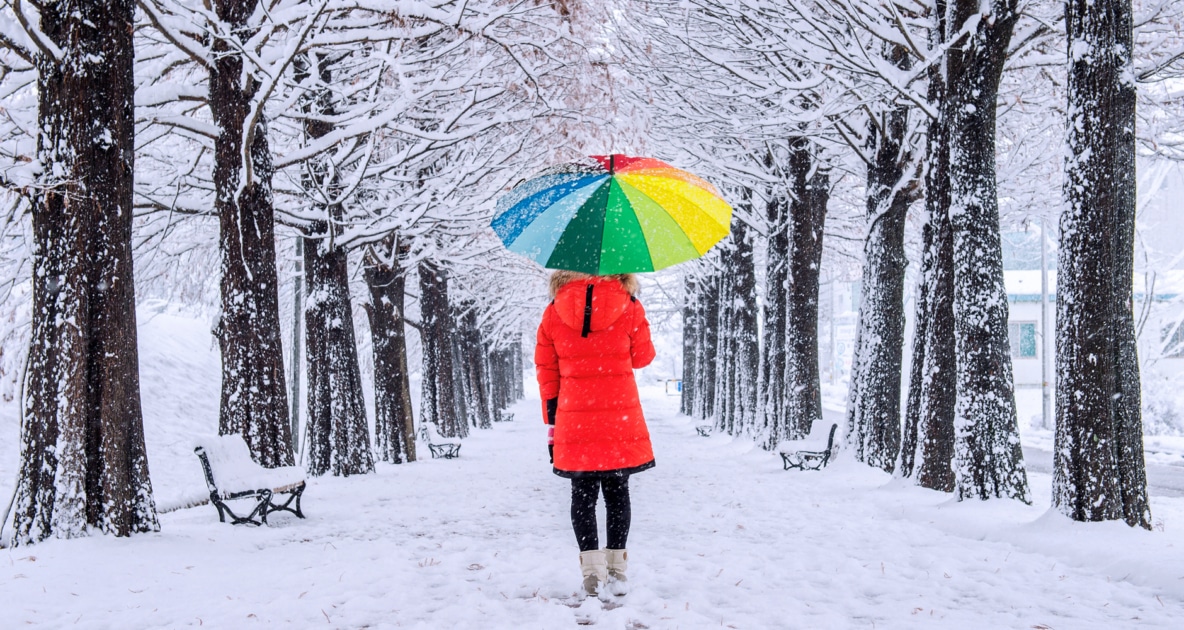2017
What We Predicted
Zone 6 January 8th-11th. Severe Pacific disturbances move inland, bringing heavy rain to the coast and valley sections, and heavy snows to the higher terrain areas (Olympic, Cascade, and Bitterroot Mountains).
What Actually Happened
Zone 6 – January 10-11: Oregon was struck with a storm that brought heavy snow to areas around Portland. The count: 8 inches at Portland International Airport and 11.8 inches downtown, making it the biggest snowstorm in about 20 years. It ranks fifth for the most snowfall at the airport in a 24-hour period, according to the weather service.
What We Predicted
Zone 1 – February 16th-19th. Near-record cold envelops the Northeast and New England. Small, but intense storm develops near the Virginia Capes and delivers a heavy snowstorm with strong winds from Maryland and Delaware northeast into Southern New England; some locations receive 1 to 2 feet of accumulation. Much lighter snow or only flurries farther north.
What Actually Happened
Zone 1 – February 12-13: Blizzard/nor’easter strikes the northeast. While we were a little late with this call, it was very close.
2016
The Farmers’ Almanac predicted that a storm would move along the Appalachian Trail in the February 24-29 time frame. Sure enough, on the 24th, a moderately strong storm was centered near Paducah, Kentucky and slid northeast to near the border of New York and Quebec by the following day. This same system brought snow and wind to the Great Lakes and Midwest. Our readers in Ohio sent us thank-you emails on February 25th when our forecast for February 24-29th called for “Becoming stormy with snow.”
In October we predicted that on the 28th-31st, it would be “turning stormy along Atlantic Seaboard, rain, widespread flooding; some wet snow in higher elevations of New England.” And sure enough, on October 28th, things turned very stormy Chilly temperatures set the stage for snow across portions of the interior Northeast on October 26-28, 2016 as a low-pressure system moved through the region. For some, it was their first snow of the season. It soon turned to heavy rain.
And who can forget the snowstorms in Colorado? We said that on March 24 – 27, a “major storm evolves over the southern Rockies,” and while a day early, on March 23rd, folks in Colorado woke up to a major storm with areas getting 1 to 2 feet, some areas received almost 3 feet (and their local weather called for 3 inches). We got emails thanking us for helping people prepare for this one!
2015
The Farmers’ Almanac forecast for wetter-than-normal summer conditions over the Southeast rang true, and our dire outlook for dry conditions to continue in the Southwest have also been spot on.
Farmers’ Almanac predicted that the winter of 2014-15 would see below-normal temperatures for about three-quarters of the nation. We called for lots of “shivery,” but we may have been a bit overzealous in terms of forecasting overall coverage of the cold air. While our prediction of very cold conditions came true in the East, the West was unusually warm.
2014
Polar Vortex Winter! Farmers’ Almanac’s predictions of a “piercing, biting, and bitterly” cold winter came true.
Snowbowl! When the 2014 edition of the Farmers’ Almanac hit the newsstands on August 26, 2013, almost immediately a rumor went viral that we were forecasting a blizzard for the Super Bowl (but as you can see, it was a rumor that – like most rumors – was not correct). And although we had actually forecast the potential for a storm within the 72-hour timeframe for Feb. 1st to 3rd, many people were concerned that forecast was valid only for the three or so hours that the game would be played. However, it was only eight hours after the big game ended, that a Winter Storm Warning was in effect and moderate-to-heavy snow was falling. By 8 a.m. on Monday the 3rd, streets were a slushy mess and flights in and out of the three major New York airports were either delayed or canceled. Eight inches of snow ultimately fell on East Rutherford, New Jersey, the site of MetLife Stadium, which ironically had been a balmy 49° at kickoff. It was literally the calm before the storm. Or as ESPN noted: “The NFL dodged a blizzard.”
Our very best forecast in 2014, however, was the winter storm that we red-flagged for February 12th-15th. It brought a wide variety of snow, ice and rain from the Southeast on up into the Northeast U.S. and was rated a Category 3 or major on the Northeast Snowfall Impact Scale (NESIS). Summer accuracy we did forewarn of hot and dry conditions in the Southwest.
2013
The Farmers’ Almanac predicted a severe heat wave along the East Coast and Great Lakes during the summer of 2013, and those predictions came true in July, with extreme heat wilting much of that region.
The Farmers’ Almanac predicted that the spring of 2013 would be unusually wet and cool across much of the U.S. and Canada. In the Northern and Central Plains and Western Great Lakes, April of that year was very cold, white, and wet that meteorologists don’t expect to see it happen again for another 50 or 100 years.
For mid-February, 2013 the Farmers’ Almanac forecast a “major Northeast snowstorm” with accumulations exceeding one foot and accompanied by strong winds causing blowing snow. And indeed, a clipper system and coastal storm merged to create blizzard conditions in parts of the Northeast. The storm dumped record-setting snowfall from New York to Maine. The highest snowfall total of 40 inches was reported in Hamden, CT. Strong winds (a gust of 83 mph was reported in Falmouth, MA) brought whiteout conditions to much of New England and whipped up waves that carved a 1,600-foot-wide hole in the barrier beach near Chatham, MA. In New York, the storm left more than one hundred cars stranded along the Long Island Expressway while in Connecticut there were reports of over a dozen collapsed roofs due to the snow. The storm left some 650,000 customers without power and resulted in a dozen deaths.
2012
The Farmers’ Almanac predicted that the summer of 2012 would be exceptionally hot in many regions of the U.S., and July 2012 proved to be the hottest month ever recorded in U.S. history.
The Farmers’ Almanac forewarned of a tropical disturbance for the Southeast during late June, 2012, and tropical storm Debby hit on June 24th.
The Farmers’ Almanac accurately predicted a wet winter of 2011-12 for Texas. Heavy precipitation helped to alleviate their severe drought, shrinking the total area affected from 43.3% in early December to 14.8% by the end of February.
The Farmers’ Almanac called for a balmy winter for the Southern and Eastern U.S. in 2011-12. For New England, New York, New Jersey, and Delaware, the winter ranked as either the second or third warmest winter in 117 years of available records. Massachusetts tied for its warmest February. It was the second warmest winter on record for Boston and New York; the fourth warmest for Washington, D.C., and Philadelphia.
The Farmers’ Almanac once again predicted a major snowstorm would hit the Rockies and Plains in the opening days of February 2012. February 2nd—4th saw a very heavy snowstorm that blanketed Colorado and Nebraska. Denver set a new snowstorm record for February of 15.9 inches.
2011
The Farmers’ Almanac accurately predicted the major winter storm that brought blizzard conditions to parts of the Southern Rockies and Central Plains on December 19th and 20th, 2011.
The Farmers’ Almanac predicted a major storm for the East Coast between October 28th and 31st, 2011. On October 29th, a deepening storm system moved up the Eastern seaboard, interacted with an unusually chilly airmass, and snowflakes began to fall. It was a stormy period for the Northeast U.S., with copious rain and even snow over higher elevations and northern New England.
The 2011 Farmers’ Almanac also forecast a hurricane threat for the Southeastern U.S. at the end of August, which came true in the form of Hurricane Irene.
The Farmers’ Almanac predicted that the spring of 2011 would be exceptionally wet, and that parts of the U.S. would see a very active tornado season. This proved to be true when flooding overwhelmed the Mississippi River Valley through several states, and killer tornadoes battered the Southeast and Midwest.
The Farmers’ Almanac accurately predicted a major snowstorm for the Northeastern and Great Lakes states for early February 2011. At that time, heavy snow did pound the Northeastern U.S., while a blizzard shut down Chicago.
2010
We predicted the summer of 2010 would be a scorcher, with hotter than normal temperatures across most areas of the U.S. and Canada through July and August. Only the Pacific Northwest was forecast to have near-normal temperatures. And that’s exactly how the summer panned out, with the mercury creeping up near, or even beyond, 100° F in areas that rarely, if ever, experience such extreme temperatures.
It’s not often that the Farmers’ Almanac long-range forecast calls for extreme events such as blizzards with two or more feet of accumulation, but that’s exactly what weather prognosticator Caleb Weatherbee saw when he consulted his data for the second week of February 2010. He was so confident, in fact, that he insisted we highlight it both in our general weather outlook and in the detailed forecast for February. As it happened, a major storm system, which has since come to be known as “Snowmageddon,” slammed Mid-Atlantic states during not one, but two blizzards over the course of a single week. The snow was so deep, it crippled whole cities, shutting down the federal government as well as cities, both large and small, in much of the Eastern half of the country. February 11-12 saw a remarkable southern snowstorm that buried cities in Texas, Louisiana, Alabama, Mississippi and Georgia. Dallas-Fort Worth recorded 12.5-inches of snow, making it their greatest 24-hour snowfall on record. Though Weatherbee’s prediction was a couple of days off, thanks to a strong El Niño system, his certainty that a major blizzard would hit in early February was right on!
2009
In 2009, the Farmers’ Almanac predicted an exceptionally cold winter and a cool, wet spring and summer for most regions. As promised, bitter cold and heavy snow punished much of the nation, coming on early in the season and lingering through the start of spring. When spring finally did arrive, it came bearing heavy rains, with twice the annual average falling in many northern states.
2008
During the summer of 2008, the Farmers’ Almanac predicted hurricane threats along the Gulf Coast, calling for one in mid-July and one in mid-August. In mid-July, Hurricane Dolly touched down on the Eastern Coast of Texas, damaging more property in the area than any storm since Hurricane Rita, three years earlier. The mid-August threat materialized into Tropical Storm Fay, which flooded portions of Southern Florida.
The Farmers’ Almanac also warned of an exceptionally active tornado season in the Midwest during the spring of 2008. Just as predicted, a record-breaking number of deadly twisters — more than 700 in all — descended on the region between February and early May.
“Trusted because it’s so darn accurate” was how one State of Maine website described the Farmers’ Almanac 2008 winter predictions. At the The Maine Cooperative Snow Survey, the author compared our predictions with actual storms, and the Farmers’ Almanac predictions were right on the money!
In its 2008 edition, the Farmers’ Almanac forecasted an extra chilly winter for the eastern half of the country, but somewhat mild west of the Mississippi River. The accuracy of that prediction was borne out by the heavier-than-normal snow that pounded most of New England and the Great Lakes region.
2007
In 2007, Farmers’ Almanac contradicted the Groundhog Punxsutawney Phil’s forecast for an early spring, accurately calling for six more weeks of winter. Less than two weeks later, blizzards slammed the Northeast, with accumulations measured in feet, not inches. Before it was over, more than seven feet had piled up in Oswego County, N.Y. In New England, snow continued through early April.
2006
In 2006, the Farmers’ Almanac accurately predicted the series of major snowstorms that hit Denver during Christmas Week, stranding travelers all over the country.
In 2006, Farmers’ Almanac predictions advised Californians to get out their umbrellas for the Tournament of the Roses Parade, and rain did, in fact, batter the parade for the first time in many years.
2005
In 2005, Farmers’ Almanac weather outlook warned that two major hurricanes would hit the same area of the Gulf Coast. Katrina and Rita devastated area at the end of that summer. Though we missed the actual dates by a few days, we were on target with our call for two hurricane strikes to the same region.
2004
In 2004, Farmers’ Almanac predictions were proven to be as good as our word when it called for an exceptionally snowy winter almost everywhere. The storms raged through late January and all of February, pounding even usually warm southern states. Temperatures in Florida ruined citrus crops.
2003
During the President’s Day Storm of 2003, Mid Atlantic states were clobbered with more than 3 feet of the white stuff. The storm caught many people off guard, but not Farmers’ Almanac readers.
1997
Farmers’ Almanac called for a nasty storm over the 1997 Christmas holidays. Snow and ice conditions that week paralyzed travelers from Texas to Washington D.C.
1996
Farmers’ Almanac predicted the Blizzard of 1996; a storm paralyzed much of the Mid-Atlantic and Northeast on January 7 and 8 of that year. Between 1 and 2 feet of snow accumulated throughout the region, leaving 100 people dead. CBS News contacted us that week for our “secret formula,” which remains a secret even today.
1995
Farmers’ Almanac called for an exceptionally warm couple of weeks during mid-to-late January in 1995, dubbing the month “Juneuary” in the pages of that year’s Farmers’ Almanac. New York City topped 70 degrees that month. Regis and Kathy Lee found our prediction notable enough to mention on air.
1993
Farmers’ Almanacaccurately predicted heavy rainfall in the Midwest throughout the summer of 1993. Copious amounts of rain that summer led to the Great Flood, which left the Mississippi River region devastated.
1992
Farmers’ Almanac predicted Hurricane Andrew in 1992, as noted by then Florida Governor Lawton Chiles, Jr., on Larry King Live.
1987-88
Though Farmers’ Almanac called for a mild winter in 1987-88, it assured the media and the International Olympic Committee that Calgary, Canada, would be snowy and cold for the 1988 Winter Olympics. Though there had been no accumulation in the mountains as of that December, Chinook winds hit the area just in time for the festivities in February. We were right on, to the day.
1954
In 1954, Farmers’ Almanac warned readers of a rare major hurricane in the Northeast. That storm turned out to be Hurricane Carol, one of the worst tropical cyclones ever to touch down in New England.
This article was published by the Staff at FarmersAlmanac.com. Any questions? Contact us at [email protected].







I wanted to mention the Ice Storm of 1994.I live in West Tennessee, and we got hammered! No power for a week, trees and power lines down everywhere.I believe it stretched across several southern states like Arkansas,Mississippi,Tennessee,etc. Thanks for allowing me to comment!
Didn’t mention the first named winter storm (Atlas) all across the north central great plains. We were without electricity in our area for 5 days. Luckily, we have a generator. Temps weren’t too bad, except pretty cold at night. I don’t remember the exact snowfall measurements in this area but it was substantial and the wind swirled and blew the snow around until virtual mountains of snow were accumulated around fences and buildings. Probably helped as insulation, actually. We couldn’t get our back patio door open for a week because it faces straight north and snow was blown onto the deck as high as 3 to 4 feet. Hard to let the dog out, so he had to learn to go to the front door when he was ready to go out.
Wow! That was quite a storm. Thank your for sharing your experience here.
I lived in Denver CO when the blizzard of 1982 happened. This storm was not mentioned so please allow me to fill you in. At the time, that storm was the biggest blizzard to hit the area in 100 years. 4 feet on the level, 10-foot drifts. The local weather forecasters failed to mention it and neither did the National Weather Service. The ensuing conditions completely stopped the city operations. The Denver airport (formerly called Stapleton Intl Airport) was closed down for days. So much snow covered the area that it took days to try to clear the area somewhat.
Hi Bonnadee,
Wow! That sounds like a huge storm. Thanks for sharing the details.
It was very huge and caught everyone off guard. One ironic memory I have is 12/23/82, the night before the storm. The weather man said “We might get a light dusting of snow for Christmas day”. Ha! On the morning of 12/24, I could not even see out the window because the snow was piled 10′ high, shutting out any daylight. It was something else.